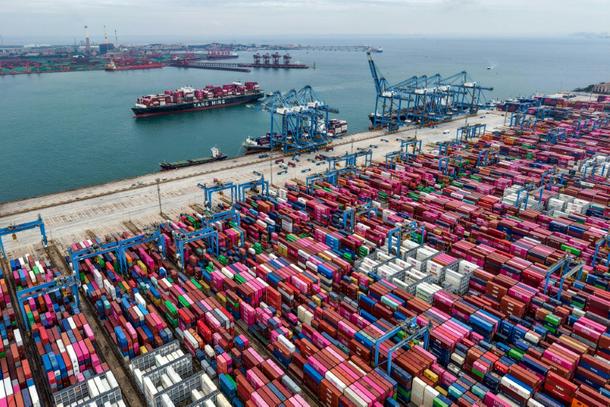
China's economy has been supported by exports, which have offset weak consumer spending
Beijing (AFP) - China’s economic growth slipped below five percent in the third quarter of 2025, official data showed Monday, the slowest pace in a year in the face of trade headwinds and a stubborn domestic consumer slump.
The data was released just hours before state news agency Xinhua announced the start of a closely watched four-day meeting in Beijing with top Communist Party officials focused on long-term economic planning.
It also comes ahead of in-person discussions later this month between top Chinese and US trade officials – as well as a potential meeting between presidents Donald Trump and Xi Jinping.
Trump earlier this month threatened blistering 100 percent tariffs on Chinese goods from November 1, in response to Beijing’s sweeping export controls in the strategic rare earths sector.
Gross domestic product in the July-September quarter expanded 4.8 percent year-on-year, the National Bureau of Statistics (NBS) said, down from 5.2 percent in the previous three months.
The figure was on par with an AFP forecast based on a survey of analysts.
It also represented the slowest growth since the same quarter last year, when GDP expanded 4.6 percent.
As trade pressure builds, experts say China must adjust to a growth model driven more by domestic household spending than exports and manufacturing.
Fixed-asset investment in the first three quarters saw a slight decline of 0.5 percent year-on-year, the data showed, largely because of a sharp contraction in real estate investment.
That decline is “rare and alarming”, Zhiwei Zhang of Pinpoint Asset Management wrote in a note.
Zhang noted that recent stimulus measures “should help to mitigate the downward pressure on investment” in the fourth quarter.
“Nonetheless, the risk to GDP growth in Q4 is likely on the downside,” he added.
- Consumer slump -
Domestic spending has lagged in recent years, having failed to fully recover from the Covid-19 pandemic.
In a further sign of weakness, the NBS said retail sales growth slid to three percent year-on-year in September, in line with estimates in a Bloomberg survey, but down from August and the slowest rate since November.
“This slowdown reflects the waning impact of the consumer goods trade-in scheme, which had boosted sales of certain products earlier in the year,” wrote Julian Evans-Pritchard of Capital Economics.
“China’s growth is becoming increasingly dependent on exports, which are offsetting a slowdown in domestic demand,” he wrote.
“This pattern of development is not sustainable,” he added.
Alin, a 40-year-old administrative assistant at an insurance company, told AFP in Beijing on Monday that she felt “current consumer subsidies are not quite enough” to get the economy humming again.
“It’s more of a global issue,” she added, noting concerns including job security, real estate prices and education-related expenses.
Another challenge facing economic planners is a protracted debt crisis in China’s vast real estate sector, long a key driver of activity.
New residential property prices fell year-on-year in September in 61 out of 70 cities surveyed, NBS data showed Monday, a sign of persisting homebuyer wariness.
In one bright spot, industrial production rose 6.5 percent last month, the data showed, outperforming the five percent forecast in a Bloomberg survey.
“The national economy withstood pressure and continued to maintain steady progress,” the NBS said in a statement about the first three quarters of the year.
Beijing and Washington agreed over the weekend to conduct a fresh round of trade talks this week as leaders attempt to walk back from the brink of another damaging tit-for-tat tariff battle.
Fears of a full-on trade war were also eased after Trump told Fox News that 100 percent levies on all Chinese goods were “not sustainable”.
Eyes are fixed on potential outcomes from the Communist Party meeting, which is due to conclude in Beijing on Thursday.